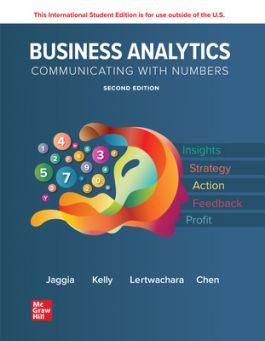Business Analytics ISE
2nd Edition
1265087687
·
9781265087685
© 2023 | Published: January 21, 2022
Business Analytics: Communicating with Numbers was written from the ground up to prepare students to understand, manage, and visualize the data, apply the appropriate tools, and communicate the findings and their relevance. Unlike other texts that si…
Read More
Request Review Access
Request More Info
Receive via shipping:
Colour, print bound version of the complete text
CHAPTER 1: Introduction to Business Analytics
CHAPTER 2: Data Management and Wrangling
CHAPTER 3: Summary Measures
CHAPTER 4: Data Visualization
CHAPTER 5: Probability and Probability Distributions
CHAPTER 6: Statistical Inference
CHAPTER 7: Regression Analysis
CHAPTER 8: Introduction to Data Mining
CHAPTER 9: More Topics in Regression Analysis
CHAPTER 10: Logistic Regression Models
CHAPTER 11: Supervised Data Mining: kNN and Naive Bayes
CHAPTER 12: Supervised Data Mining: Decision Trees
CHAPTER 13: Unsupervised Data Mining
CHAPTER 14: Forecasting with Time Series Data
CHAPTER 15: Spreadsheet Modelling
CHAPTER 16: Risk and Simulation
CHAPTER 17: Optimization: Linear Programming
CHAPTER 18: Optimization: Integer and Nonlinear Programming
APPENDIX A Big Data Sets: Variable Description and Data Dictionary
APPENDIX B Getting Started with Excel and Excel Add-Ins
APPENDIX C Getting Started with R
APPENDIX D Statistical Tables
APPENDIX E Answers to Selected Exercises
CHAPTER 2: Data Management and Wrangling
CHAPTER 3: Summary Measures
CHAPTER 4: Data Visualization
CHAPTER 5: Probability and Probability Distributions
CHAPTER 6: Statistical Inference
CHAPTER 7: Regression Analysis
CHAPTER 8: Introduction to Data Mining
CHAPTER 9: More Topics in Regression Analysis
CHAPTER 10: Logistic Regression Models
CHAPTER 11: Supervised Data Mining: kNN and Naive Bayes
CHAPTER 12: Supervised Data Mining: Decision Trees
CHAPTER 13: Unsupervised Data Mining
CHAPTER 14: Forecasting with Time Series Data
CHAPTER 15: Spreadsheet Modelling
CHAPTER 16: Risk and Simulation
CHAPTER 17: Optimization: Linear Programming
CHAPTER 18: Optimization: Integer and Nonlinear Programming
APPENDIX A Big Data Sets: Variable Description and Data Dictionary
APPENDIX B Getting Started with Excel and Excel Add-Ins
APPENDIX C Getting Started with R
APPENDIX D Statistical Tables
APPENDIX E Answers to Selected Exercises
Business Analytics: Communicating with Numbers was written from the ground up to prepare students to understand, manage, and visualize the data, apply the appropriate tools, and communicate the findings and their relevance. Unlike other texts that simply repackage statistics and traditional operations research topics, this text seamlessly threads the topics of data wrangling, descriptive analytics, predictive analytics, and prescriptive analytics into a cohesive whole. It provides a holistic analytics process, including dealing with real life data that are not necessarily 'clean' and/or 'small' and stresses the importance of effectively communicating findings by including features such as a synopsis (a short writing sample) and a sample report (a longer writing sample) in every chapter. These features help students develop skills in articulating the business value of analytics by communicating insights gained from a non-technical standpoint.

